Abstract
One hundred ninety-two isolates from cecal contents of three normal weaned pigs were obtained by means of anaerobic roll tube methods and were characterized. Seventy-eight percent of the isolates were gram-negative. The most numerous species isolated from each of the pigs was Bacteroides ruminicola. This species accounted for 35% of the isolates that were characterized, and Selenomonas ruminantium accounted for 21% of the isolates. Other gram-negative bacteria isolated from all three pigs were Butyrivibrio fibrisolvens (6.0%) and Bacteroides uniformis (3.0%); predominant gram-positive isolates were Lactobacillus acidophilus (7.6%), Peptostreptococcus productus (3.0%), and Eubacterium aerofaciens (2.5%). The other 42 isolates were placed in 14 other species, and 5 additional isolates that did not fit well into existing species were not placed taxonomically. Fifteen of the isolates (representing nine species) produced urease.
Full text
PDF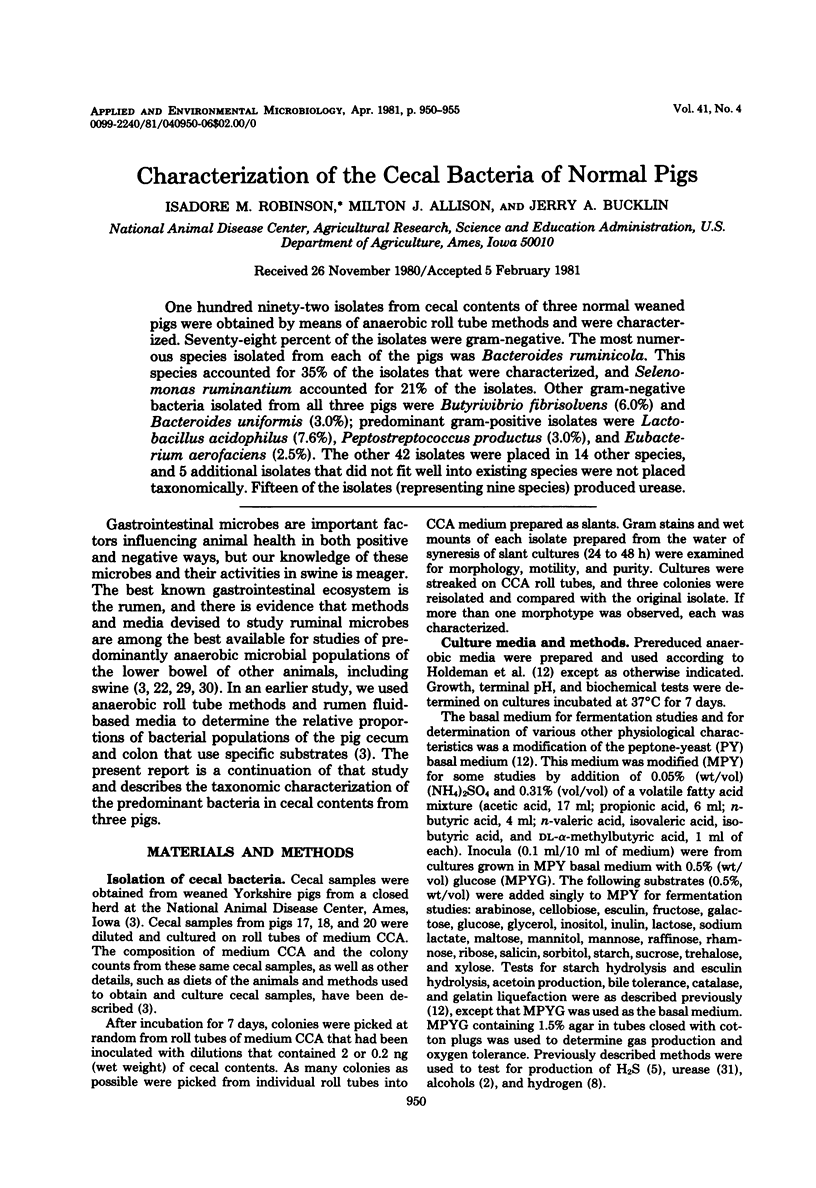
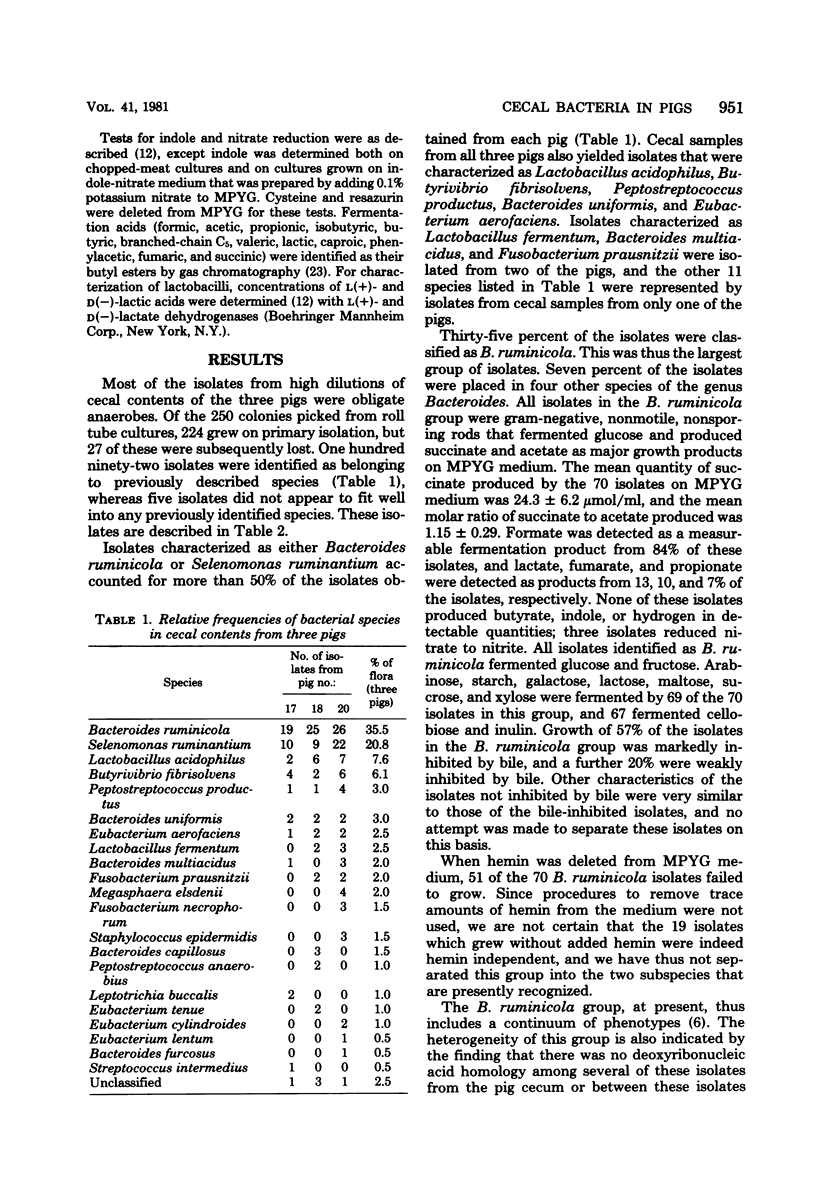
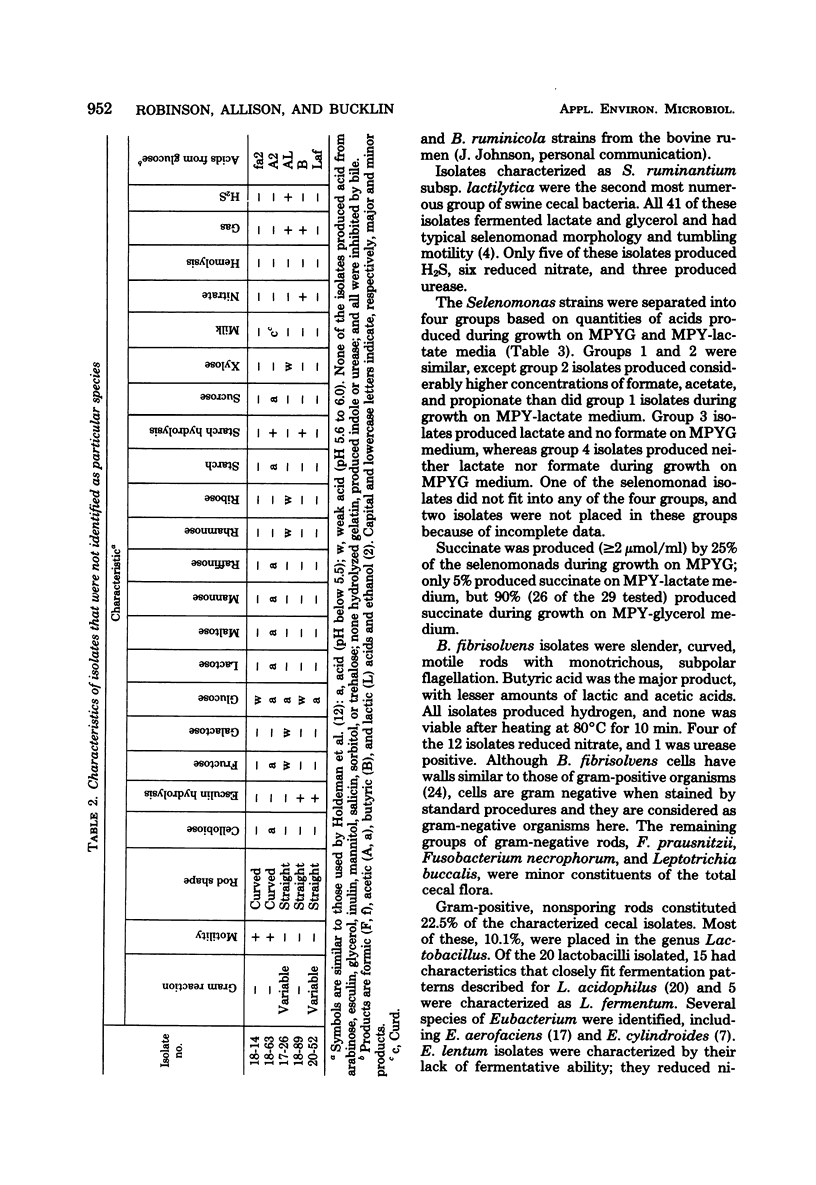
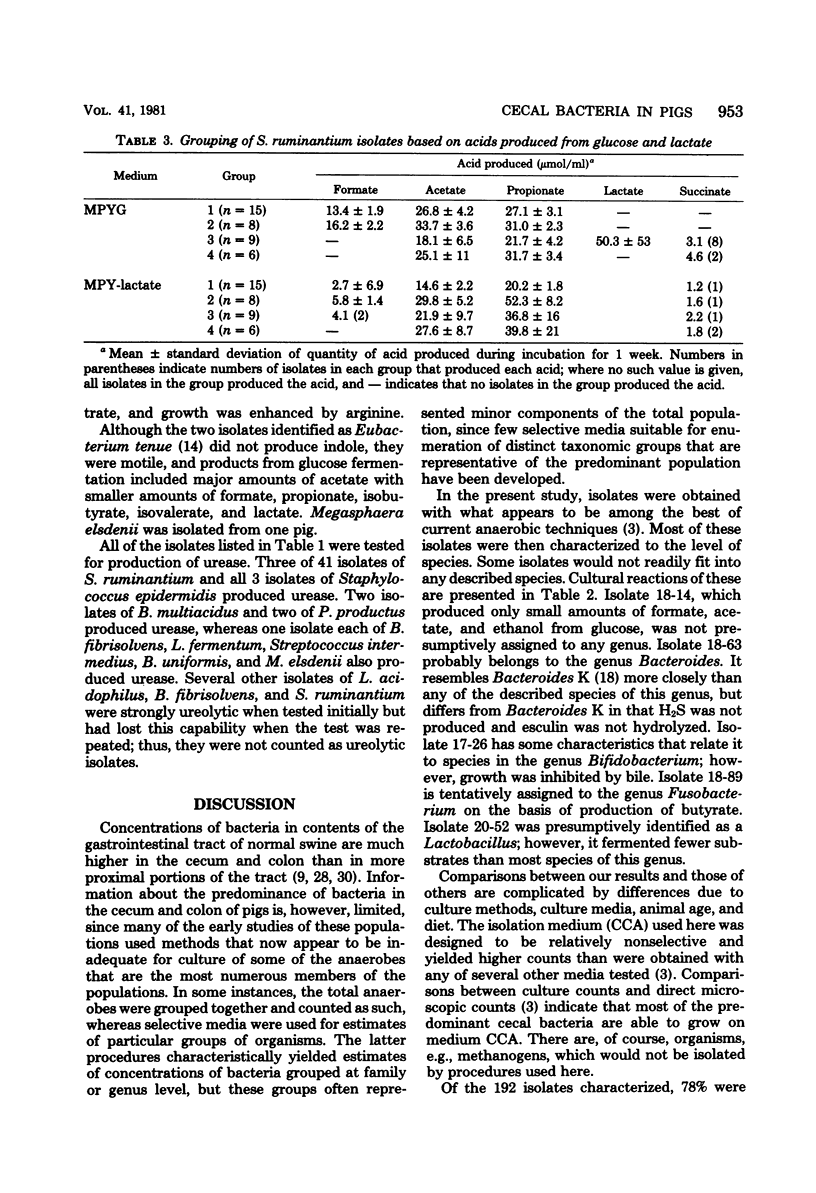
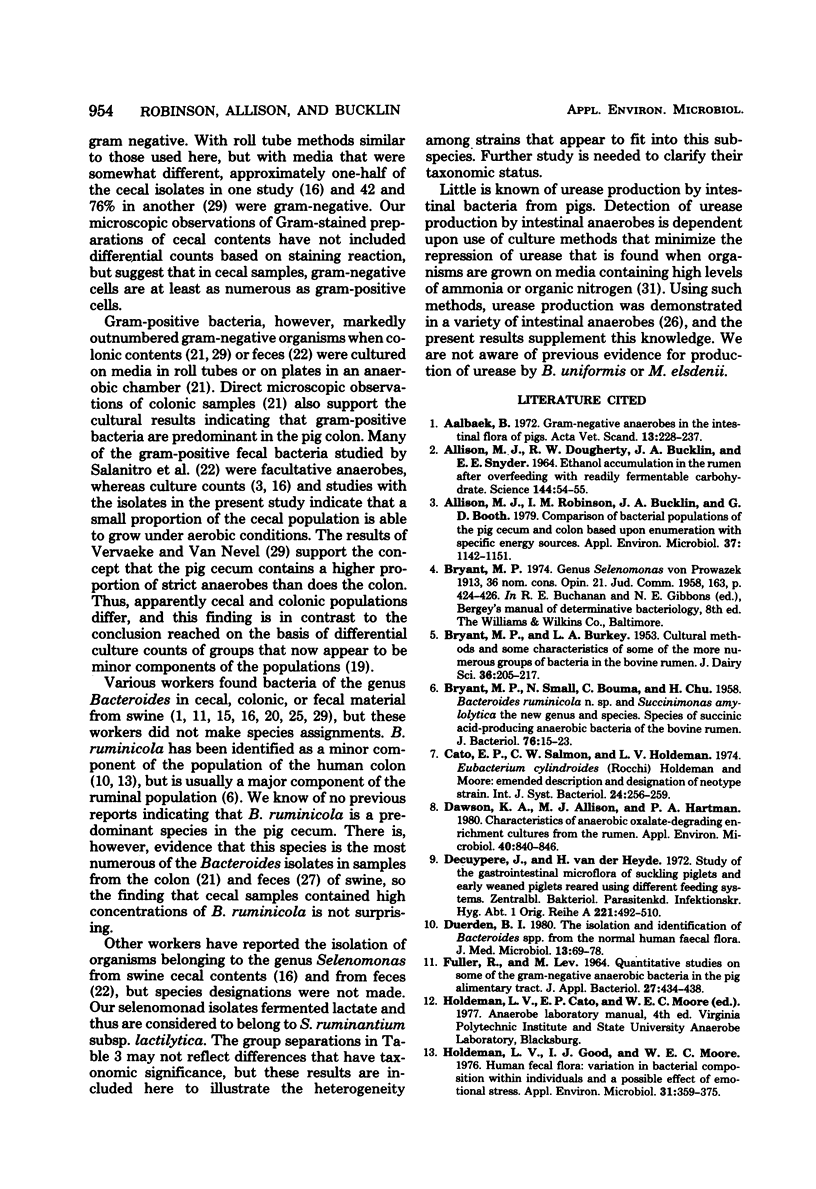
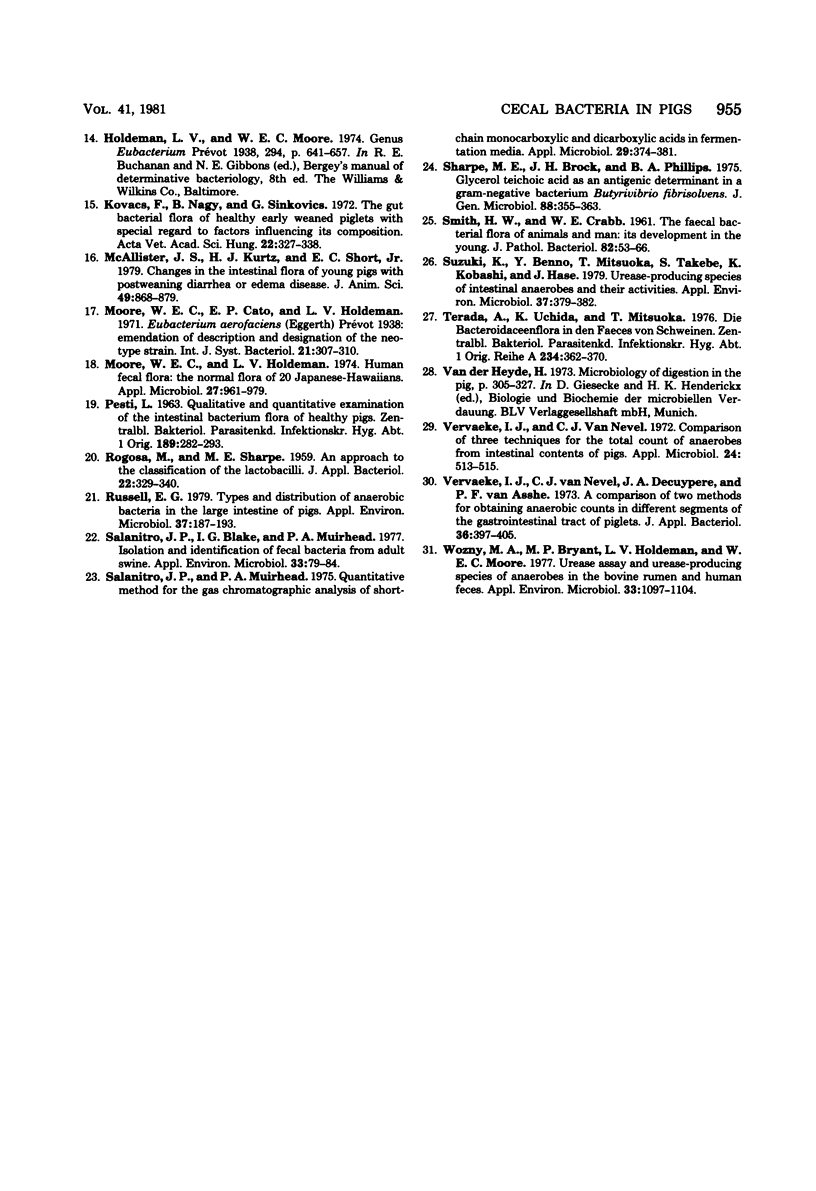
Selected References
These references are in PubMed. This may not be the complete list of references from this article.
- ALLISON M. J., DOUGHERTY R. W., BUCKLIN J. A., SNYDER E. E. ETHANOL ACCUMULATION IN THE RUMEN AFTER OVERFEEDING WITH READILY FERMENTABLE CARBOHYDRATE. Science. 1964 Apr 3;144(3614):54–55. doi: 10.1126/science.144.3614.54. [DOI] [PubMed] [Google Scholar]
- Aalbaek B. Gram-negative anaerobes in the intestinal flora of pigs. Acta Vet Scand. 1972;13(2):228–237. doi: 10.1186/BF03548576. [DOI] [PMC free article] [PubMed] [Google Scholar]
- Allison M. J., Robinson I. M., Bucklin J. A., Booth G. D. Comparison of bacterial populations of the pig cecum and colon based upon enumeration with specific energy sources. Appl Environ Microbiol. 1979 Jun;37(6):1142–1151. doi: 10.1128/aem.37.6.1142-1151.1979. [DOI] [PMC free article] [PubMed] [Google Scholar]
- BRYANT M. P., SMALL N., BOUMA C., CHU H. Bacteroides ruminicola n. sp. and Succinimonas amylolytica; the new genus and species; species of succinic acid-producing anaerobic bacteria of the bovine rumen. J Bacteriol. 1958 Jul;76(1):15–23. doi: 10.1128/jb.76.1.15-23.1958. [DOI] [PMC free article] [PubMed] [Google Scholar]
- Dawson K. A., Allison M. J., Hartman P. A. Characteristics of anaerobic oxalate-degrading enrichment cultures from the rumen. Appl Environ Microbiol. 1980 Oct;40(4):840–846. doi: 10.1128/aem.40.4.840-846.1980. [DOI] [PMC free article] [PubMed] [Google Scholar]
- Decuypere J., Van der Heyde H. Studien uber die gastro-intestinale Mikroflora von Saugferkeln und frühentwölhnten Ferklen bei Aufzucht nach verschiedenen Füterungssystemen. Zentralbl Bakteriol Orig A. 1972 Sep;221(4):492–510. [PubMed] [Google Scholar]
- Duerden B. I. The isolation and identification of Bacteroides spp. from the normal human faecal flora. J Med Microbiol. 1980 Feb;13(1):69–78. doi: 10.1099/00222615-13-1-69. [DOI] [PubMed] [Google Scholar]
- Holdeman L. V., Good I. J., Moore W. E. Human fecal flora: variation in bacterial composition within individuals and a possible effect of emotional stress. Appl Environ Microbiol. 1976 Mar;31(3):359–375. doi: 10.1128/aem.31.3.359-375.1976. [DOI] [PMC free article] [PubMed] [Google Scholar]
- Kovács F., Nagy B., Sinkovics G. The gut bacterial flora of healthy early weaned piglets, with special regard to factors influencing its composition. Acta Vet Acad Sci Hung. 1972;22(4):327–338. [PubMed] [Google Scholar]
- McAllister J. S., Kurtz H. J., Short E. C., Jr Changes in the intestinal flora of young pigs with postweaning diarrhea or edema disease. J Anim Sci. 1979 Sep;49(3):868–879. doi: 10.2527/jas1979.493868x. [DOI] [PubMed] [Google Scholar]
- Moore W. E., Holdeman L. V. Human fecal flora: the normal flora of 20 Japanese-Hawaiians. Appl Microbiol. 1974 May;27(5):961–979. doi: 10.1128/am.27.5.961-979.1974. [DOI] [PMC free article] [PubMed] [Google Scholar]
- PESTI L. QUALITATIVE AND QUANTITATIVE EXAMINATION OF THE INTESTINAL BACTERIUM FLORA OF HEALTHY PIGS. Zentralbl Bakteriol Orig. 1963 Jul;189:282–293. [PubMed] [Google Scholar]
- Russell E. G. Types and distribution of anaerobic bacteria in the large intestine of pigs. Appl Environ Microbiol. 1979 Feb;37(2):187–193. doi: 10.1128/aem.37.2.187-193.1979. [DOI] [PMC free article] [PubMed] [Google Scholar]
- Salanitro J. P., Blake I. G., Muirhead P. A. Isolation and identification of fecal bacteria from adult swine. Appl Environ Microbiol. 1977 Jan;33(1):79–84. doi: 10.1128/aem.33.1.79-84.1977. [DOI] [PMC free article] [PubMed] [Google Scholar]
- Salanitro J. P., Muirhead P. A. Quantitative method for the gas chromatographic analysis of short-chain monocarboxylic and dicarboxylic acids in fermentation media. Appl Microbiol. 1975 Mar;29(3):374–381. doi: 10.1128/am.29.3.374-381.1975. [DOI] [PMC free article] [PubMed] [Google Scholar]
- Sharpe M. E., Brock J. H., Phillips B. A. Glycerol teichoic acid as an antigenic determinant in a Gram-negative bacterium Butyrivibrio fibrisolvens. J Gen Microbiol. 1975 Jun;88(2):355–363. doi: 10.1099/00221287-88-2-355. [DOI] [PMC free article] [PubMed] [Google Scholar]
- Suzuki K., Benno Y., Mitsuoka T., Takebe S., Kobashi K., Hase J. Urease-producing species of intestinal anaerobes and their activities. Appl Environ Microbiol. 1979 Mar;37(3):379–382. doi: 10.1128/aem.37.3.379-382.1979. [DOI] [PMC free article] [PubMed] [Google Scholar]
- Terada A., Uchida K., Mitsuoka T. Die Bacteroidaceenflora in den Faeces von Schweinen. Zentralbl Bakteriol Orig A. 1976 Apr;234(3):362–370. [PubMed] [Google Scholar]
- Vervaeke I. J., Van Nevel C. J. Comparison of three techniques for the total count of anaerobes from intestinal contents of pigs. Appl Microbiol. 1972 Sep;24(3):513–515. doi: 10.1128/am.24.3.513-515.1972. [DOI] [PMC free article] [PubMed] [Google Scholar]
- Vervaeke I. J., Van Nevel C. J., Decuypere J. A., Van Assche P. F. A comparison of two methods for obtaining anaerobic counts in different segments of the gastro-intestinal tract of piglets. J Appl Bacteriol. 1973 Sep;36(3):397–405. doi: 10.1111/j.1365-2672.1973.tb04121.x. [DOI] [PubMed] [Google Scholar]
- Wozny M. A., Bryant M. P., Holdeman L. V., Moore W. E. Urease assay and urease-producing species of anaerobes in the bovine rumen and human feces. Appl Environ Microbiol. 1977 May;33(5):1097–1104. doi: 10.1128/aem.33.5.1097-1104.1977. [DOI] [PMC free article] [PubMed] [Google Scholar]


